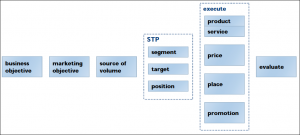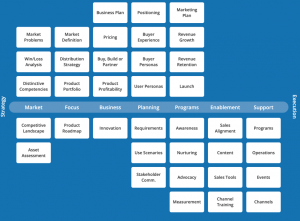Marketing Career Guide

Marketers get to have the most fun in business in my opinion because they are at the intersection of creativity and analytics. In my more than ten years of professional experience, over half of that has been in digital marketing. It is certainly one of the fastest growing fields out there and it is still just getting started. Soon the terms “marketing” and “digital marketing” will be synonymous. Hopefully the information below can give you a sense of what the field is like.
For why I have chosen this career, see my Personality-Career Fit page.
Product Marketing
In Tech, Product Marketing Managers sit in between sales and product to position solutions.
Two Key Responsibilities:
- Know the product
- Feed sales
Two Important Documents to Produce:
- Product Positioning Statement
The quintessential way to do this is from Geoffrey Moore’s book “Crossing the Chasm”:
-
- For [target end user]
- Who wants/needs [compelling reason to buy]
- The [product name] is a [product category]
- That provides [key benefit].
- Unlike [main competitor],
- The [product name] [key differentiation]
- Buyer Persona Cards
This is a fictional representation of your target customer, based on the following data:
-
- Demographics
- Likes
- Job
- Education
- Goals
- Values
- Pain points
Key Skills:
- Writing
- Presenting
- Demand Generation
- Business Acumen
Broader Responsibilities:
- Understanding product’s unique value or points of differentiation
- Creating content strategy
- Delivering presentations at internal and external events
- Driving market research to gather insights
- Craft Go-to-Market programs on how to promote product
- Focus on customers, rather than leads
- Understand buyer personas
- Identify customer pain points
- Provide Sales Enablement materials to aid sales teams in customer conversations
Additional resources:
Digital Marketing (or Performance Marketing)
Digital Marketing (or Performance Marketing) is the fastest growing channel in marketing and soon, there “digital marketing” and “marketing” will not be separate terms. As someone with more than five years in digital marketing, this is a topic that is near and dear to my heart. There are a few basics to be aware of when considering this field.
- Company Website: This is the end all be all for the company’s digital marketing strategy. It is used for branding, consumer research, sales and customer communication. The purpose is to entice a customer to continue to be interested in the products and services. This could be possibly the first interaction a customer has with the company and it is important for this to be top notch.
- Digital Advertising: Companies pay publishers, including web site hosts, search engines, and the like, to promote it’s products. This comes through several channels including banner ads, videos, text messaging, digital billboards, email newsletters and the list goes on.
- Digital Content Management: Developing, curating and publishing content for the purpose of connecting customers with a company is key. This is an effective way to engage with customers beyond advertising. With ads, it is like having someone but into you conversation at a party and taking over the topic of discussion. Content marketing is more like someone who comes into join the existing conversation. Content that is relevant to the customer’s goals, not pushing products, is a fast way to gain interest.
- Search Engine Optimization (SEO): We’re all familiar with Google. Well, how do you get your companies content to rank highly on search results organically? SEO!
- Search Engine Marketing (SEM): This is also called Pay Per Click, meaning the advertiser only pays for click, not impressions.
- Email Marketing: I think most of us are familiar with this. However, if you were to breakdown digital marketing into three channels, internet, social and email, the latter would be the most targeted.
- Analytical Tools: No other medium of marketing is as measurable and controllable as digital. Attribution is much easier with this medium compared to all other options. And better yet, the information can sometime be available immediately! A far cry from some traditional advertisements on TV and Radio. Tacking, measuring and reporting have never been easier.
- Social Media Marketing: Ever hear of Facebook? Yeah, I’m sure you’ve seen the ads. Well, there is a career for in that. Getting a companies content out there through social media channels can be a powerful way to distribute a message. However, it is not all rainbows and puppies as you are relinquishing some control when putting you content on platforms owned by other companies.
Forms of Marketing
- Owned Media: Media that is directly controlled by the company advertising it’s products. This includes the corporate website, blogs, etc.
- Paid Media: This includes a company paying a publisher to promote their message on a third part platform. This includes banner ads and search engine marketing.
- Earned Media: When customers, news media and the public at large start promoting and sharing the companies content, they do the marketing for you! Viral posts, videos and the like are included in this category.
Additional Resources:
Mobile Marketing
- Mobile Sites: It is important for companies to adapt to the platforms consumers are using. You know how poorly a desktop site renders on a mobile device. It is too large, to slow and too cumbersome to navigate. There are two ways to offset this. A Responsive Web Design (RWD) page is built so that it will adapt to whatever device and screen size it is being used for. This is preferable as you only have to build one site. The other is to create a device specific site.
- Email: About half of all email is opened on mobile devices now. Open rates skyrocketed in in the early part of this decade with the proliferation of cell phone use.
- Quick Response (QR) Codes: Yeah, they still exist. They can be handy too when you want to have customers have easy access to more information about your company, especially while they are on the go.
- Mobile Payments: Most of us have probably used Apple Pay or Android Pay at this point. Not to mention Venmo and it’s wonderful Person to Person (P2P) capabilities. This mediums will continue to grow and may perhaps be the primary way to make payments in the future.
- Augmented Reality: This is still in is nascent stage, but when you superimpose media over real world environments in real-time, that is augmented reality. Kind of like Minority Report or Iron Man, but through a lens. This will be huge for marketers to help customers view physical products in real time and have digital displays of the product details. Or even better, coupons!
- SMS or Text Message Marketing: We’ve all been spammed texted before, but done right, text messaging can be a powerful and immediate way to reach customers.
Industry Marketing
In my experience, there are lots of similarities between industry marketing and product marketing with a few key differences.
- Focus on industry vertical, instead of focusing on one product
- Package industry solutions according to segment needs
- Cover additional activities that include events and demand generation
- Understand industry issues
Additional resources:
Brand Management
If you are an MBA grad, Brand Management is the holy grail of marketing careers. While I don’t have experience with the role, I’ve certainly rubbed shoulders and done enough informational interviews to tell you some basics about what it entails. Typically this is in the Consumer Packaged Good Industry or CPG. You also have many Product Managers in the Tech Industry as well. Obviously, I’m not an authority by any means, but when it comes to marketing careers, this is one of the hottest jobs out there.
In essence, as a Brand Manager, you are in charge of everything for a product. Using the four P’s you lead the Promotion, Pricing, Placement and the development of the Product itself. That includes activities such as managing advertising, operations, distribution and finance. It is like being an entrepreneur and running your own small business. It is key to have robust general management skills since you will need work with multiple functional areas.
Marketing Principles, Strategies and Frameworks
There are a few foundations to ground yourself in as a marketer. I’ve listed them below.
Marketing Funnel
Used as a critical process of turning leads into customers. The key pieces to focus on are Awareness, Interest and Consideration. Digital Marketing covers the first two. Product Marketing leans in on the last.

Source: How the Marketing Funnel Works from Top to Botton
7 Ps of Marketing
Used for developing and evaluating marketing strategy
- Product
- Price
- Promotion
- Place
- Packaging
- Positioning
- People
Source: The 7 Ps of Marketing
Product Positioning
Used for positioning messaging, typically in tech.
- For [target end user]
- Who wants/needs [compelling reason to buy]
- The [product name] is a [product category]
- That provides [key benefit].
- Unlike [main competitor],
- The [product name] [key differentiation]
Source: Crossing the Chasm by Geoffrey Moore
Big Picture Framework
Used for creating marketing plans.

Source: Big Picture Partners
ADPLAN Framework
Used for evaluating creative ads
- Attention
- Distinction
- Positioning
- Linkage
- Amplification
- Net equity
Source: Kellogg Bowl – 2019 Super Bowl Ad Review
Go-to-Market Strategy
Used to design how to put place offerings into the market, encompassing the entire product lifecycle.
- Product
- Value Prop
- Channels
- Partnerships
- Communication plan
Source: Fourquadrant Go-to-Market Strategy
Pragmatic Marketing Framework
Used as a blueprint of key activities to bring products to market.

Source: Pragmatic Marketing Framework
Market Sizing Framework
Used to understand the size of a market.

Source: Product Monk
3C & P Framework
Used for new business, new product, new market entry, growth strategy and company assessment.
- Customers
- Company
- Competition
- Product
Source: 3C&P Consulting Framework
STP Framework
Used for market research
- Segmenting
- Targeting
- Positioning
Source: Smart Insights
Porter’s Value Chain
Used for Product analysis, cost analysis, competitive advantage, management strategy. (In case you were wondering, I did not create this).
- Inbound Logistics – All the processes related to receive, storing and distributing inputs internally
- Operations – Transformation activities that change inputs into finished products and services
- Outbound Logistics – Activities that deliver your finished product or service to your customer
- Service – Activities related to maintaining the value of your product or service to your customers, once it has been purchased
Source: Mind Tools
Skills
Project Management
- Create and manage timelines
- Plan initiatives and set priorities
- Multi-task several projects at once
Analytical
- Analyze sales, impressions, clicks, profits
- Evaluate customer segmentation
- Understand and navigate measurement systems like IBM CoreMetrics, Adobe Target, Google Analytics
Cross-Functional Leadership
- Influence without direct authority
- Motivate others with positive techniques who have differing priorities and projects
- Work across different teams including sales, advertising, finance, and external ad agencies
Problem Solving
- Come up with new and innovative ways to overcome challenges
- Use the resources available to you in an effective and efficient manner
- Address both long-term and short-term issues
Creativity
- Consider alternatives to solving problems
- Be able to provide input to media development
- Have fun
